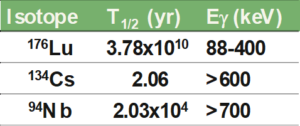PageContent
PANDORA
Plasma for Astrophysics, Nuclear Decays Observation and Radiation for Archaeometry
Local Responsible: + Fabrizio Odorici

Scientific goals
Experiments performed on Storage Rings have shown that lifetimes of β-radionuclides can change dramatically as a function of the ionization state. The PANDORA experiment aims at measuring, for the first time, nuclear β-decay rates in stellar-like conditions. The study will be mainly focused on radionuclides involved in nuclear-astrophysics processes (Big Bang Nucleosynthesis, s-processing, Cosmo-Chronometers, Early Solar System formation). Compact magnetic plasma traps, where plasmas reach electron density values ne~1011-1014 cm-3 and a wide range of average electronic temperatures Te~0.1-30 keV, depending on the working conditions, are suitable for such studies. The decay rates can be measured as a function of the charge state distribution of the in-plasma ions. The present activity of the collaboration is now focused on the design of the plasma trap able to reach the needed plasma densities, temperatures and charge states distributions. More details can be found in “The PANDORA project: an experimental setup for measuring in-plasma β-decays of astrophysical interest – EPJ Web of Conferences 227, 01013 (2020)“
Activity
The plasma trap of PANDORA is foreseen to be installed at the INFN-LNS laboratory in the next years. The 1st phase of the experiment (5 years) is started in January 2020 and will deal with the construction of the infrastructure (the magnetic system for the plasma trap and array of HpGe detectors) and the preparation of the experiment (models and theory, calibrations and measurements). The first data taking period is expected to run along 2023 and 2024, to study three physics cases: in plasma β-decay rates for the isotopes reported in the following table.

The Collaboration, local activity and responsibilities
The PANDORA experiment is an international Collaboration. The project is currently financed by the INFN Scientific National Commission 3. The INFN units participating to the experiment are four: LNS (M. David, principal investigator), LNL (A. Galatà, local resp.), Sezione di Perugia (M. Busso, local resp.) and Sezione di Bologna (F. Odorici, local resp.). Other national institutes involved in the experiment are INAF-OACT and CNR-IBAM. Collaborating international institutes are: Hungarian Academy of Sciences, University of Michigan, CNRS-LPSC Grenoble – France, GANIL – France, Max Plank Institute – IPP Garching, Germany.
The INFN Bologna group is currently composed by Alberto Mengoni, Marco Cuffiani, Luciana Malferrari and Fabrizio Odorici. However, other colleagues in Bologna are involved in the experiment and are next to formally participate. The main local responsibilities are:
- Development of the inner plasma chamber.
+ Show moreThe inner plasma chamber consists of a (thin) active coating of the main chamber and provides an electrical segmentation of the cylinder’s wall; each segment is anodized on the external surface (and on the edges) so that, being electrically isolated from the neighbor, it is possible to polarize it with a given voltage. Each segment will then be connected to earth by means of an I-V measurement circuit, performing a double function: firstly, it will be possible to measure the plasma leakage currents based on an axial segmentation, and secondly it will be possible optimize the configuration of the polarization of the wall in a differentiated way, in order to minimize radial losses and optimize the characteristics of the plasma.
- Theoretical nuclear physics aspects and background reduction.
+ Show moreTheoretical calculation of the expected decay rates and emission spectra are needed to determine the expected signal (γ-rays) of a given isotope with a β-decay; a simulation of the expected background (due to plasma γ-emission from hot electron bremsstrahlung) is needed and (in some cases) a technique to reduce it has to be applied in order to improve the signal to noise ratio. To reduce the γ-background from hot electrons, Bologna will develop an electron gun that will inject auxiliary low energy electrons into the plasma chamber. This technique allow to improve the plasma stability and to reduce the density of hot electrons into the plasma.
Opportunities for thesis and master’s thesis are available (email: odorici@bo.infn.it)












